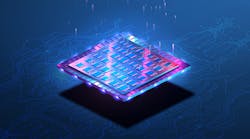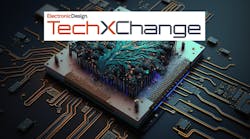Powering the AI Revolution: Silicon Photonics and the Future of Data Centers
What you’ll learn:
- How AI is pushing the demand for faster data processing and transfer.
- How silicon photonics promises to accelerate AI computations and addresses critical challenges faced by modern data centers to meet these demands.
- The future of AI and data centers.
The artificial-intelligence (AI) revolution continues to reshape the technology landscape at an unprecedented pace. This transformation is having a profound impact on how to build data centers, presenting a number of challenges and opportunities.
At the heart of this revolution lies a burgeoning technology: silicon photonics. This cutting-edge advance merges the realms of optics and electronics. It utilizes decades of investment in silicon semiconductors for electronics to create complex photonic integrated circuits (PICs) capable of manipulating and even generating light that can be manufactured at scale.
As AI models grow exponentially in size and complexity, the demand for faster data processing and transfer becomes critical. Silicon photonics not only promises to accelerate AI computations, but also addresses critical challenges faced by modern data centers, primarily how to meet these demands without creating unsustainable levels of power consumption and heat generation.
The AI Data Explosion
The rapid advancement of AI, particularly generative AI, also comes with significant demands on data storage and energy consumption—around 10% to 20% of U.S. data-center energy is already being consumed by AI, but that’s set to increase significantly. As AI models grow in complexity and capability, the need for robust data-center infrastructure becomes more pressing.
Industry projections from JLL estimate that global data-center storage capacity will soar from 10.1 zettabytes (ZB) in 2023 to a staggering 21.0 ZB by 2027—an annual growth rate of 18.5%. This exponential increase in data-storage requirements is driven primarily by AI systems, such as large language models (LLMs), and the vast amounts of data they need for training and efficient operations. Data access will require ever-increasing velocity, pushing the demand for high-bandwidth links into layers of the network that haven’t previously needed the bandwidth provided by optical links.
The energy demands of generative AI models are equally staggering, ranging from 300 to over 500 MW of critical IT load capacity. This power-consumption level raises critical questions about the sustainability and environmental impact of AI-driven data centers.
>>Check out these TechXchanges for similar articles and videos
The Two-Headed Beast: Front- and Back-End Challenges
To understand the full scope of the challenge, it’s necessary to look at both the front and back end of data-center architecture in the context of AI.
Front end
The front end, or what’s now thought of as conventional data-center architecture, is evolving more slowly when compared with the back end. Adoption of new technologies in these Ethernet-centric systems no longer sets the pace despite bandwidth demands roughly doubling every couple of years.
Back end
This is where AI networks reside, and it’s a different beast entirely. These networks push the boundaries of technology, utilizing the latest graphics processing units (GPUs) and specialized system-on-chips (SoCs) connected in highly meshed topologies that require frequent reconfiguration to meet the needs of specific tasks. They’re also more risk-tolerant, needing to adopt new technologies much faster to keep up with demand.
The “rule of 10” is a common framework to explain how much data is required to train an AI model. AI models need at least 10 examples for each feature or predictor variable. The amount of data that must be processed significantly increases as models become more advanced and mature. The algorithm for ChatGPT alone was trained on 570 GB of text data. The sheer volume of data processing and the interconnectivity between elements required in AI networks means that the number of links needed is exponentially greater than for traditional front-end systems.
In AI networks, capacity is increasing tenfold every two years—a rate that’s putting immense pressure on current infrastructure and manufacturing capabilities. For hardware providers, the current method used to build optics presents significant challenges in the ability to scale up manufacturing capacity to meet this demand.
For operators and designers managing heat in denser computing environments, securing sustainable energy sources for power-hungry data centers, and establishing industry-wide standards for interoperability and performance, are top-of-mind concerns. Overcoming these hurdles will require collaboration across the industry and innovative approaches to design, cooling, and energy management.
The Silicon Photonics Solution
As the industry grapples with these challenges, silicon photonics emerges as a critical technology in advancing the AI revolution. Silicon photonics allows for the development of compact and densely packed PICs, enabling the creation of high-density bandwidth connections crucial for AI/ML workloads. By integrating optical components directly onto silicon chips, key issues facing AI-driven data centers can be addressed:
- Energy demands: Silicon photonics, particularly when combined with heterogeneous integration techniques, offers significant power savings. By integrating components made of semiconductor materials, such as indium phosphide, which can generate, modulate, and amplify light directly onto silicon, it’s possible to lower drive voltages and improve coupling efficiencies. For instance, while external coupling of lasers into PICs typically achieves only 30% efficiency, heterogeneous integration can consistently reach up to 90% coupling efficiency. This means lasers can be driven less intensively, dramatically reducing power consumption and improving reliability.
- Scalability and speed: AI networks require unprecedented speeds and bandwidth. Because light can travel faster than electricity, photonics transfer data faster over longer distances than traditional electronics. Silicon photonics allows for the integration of active and passive components on a single chip, enabling system and module providers to rapidly scale up production. Such integration simplifies assembly and integration with electronics, reducing capital expenditure and lead times.
- Cost-effectiveness: The volume demands of AI networks are pushing conventional manufacturing technologies to their limits. Silicon photonics, with its ability to leverage existing semiconductor manufacturing infrastructure, offers a path to more cost-effective production by enabling fabrication and testing at wafer scale. This leads to substantial CAPEX and OPEX cost savings in back-end manufacturing and assembly costs, while giving rise to a new generation of PICs that have the capacity to house multiple channels and, as a result, larger data-processing levels.
- Density and performance: By integrating multiple optical functions onto a single chip, silicon photonics begets higher density and performance in data-center interconnects. This is crucial for meeting the exponential growth in AI network capacity. These ultra-high-density optical chips are uniquely positioned to influence information processing because of their transmission and processing capabilities. They’re also highly scalable, allowing them to manage large amounts of data all at once.
- Supply chain: Silicon photonics solutions present a new and better way to do photonics utilizing the existing silicon infrastructure. It includes the robust, established supply chain that continues to expand, the industry know-how, and established companies. Whether it’s foundry, design tools, testing, or packaging, part of the beauty of silicon photonics is that companies aren’t starting from ground zero.
An Eye Toward the Future
The AI revolution is pushing data-center infrastructure to its limits, but it’s also driving innovation at an outstanding pace. Silicon photonics, with its potential for high-speed, energy-efficient, and scalable solutions, is poised to play a pivotal role in this transformation.
By replacing traditional electronic interconnects with photonic options, silicon photonics paves the way for more efficient, higher-bandwidth data centers that can keep pace with the insatiable appetite of AI algorithms for data and computing power. With continued innovation and collaboration, it’s possible to harness the power of AI while building a more sustainable and efficient digital infrastructure for generations to come.
The future of AI and data centers is bright, but it requires collaboration across the industry—from chip designers to system integrators and data-center operators to energy providers. Together, the industry can build the foundation for an AI-powered future that’s not only powerful and transformative, but also sustainable and accessible.


